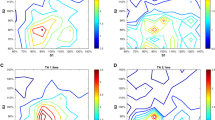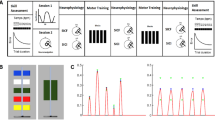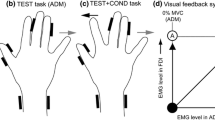Abstract.
We investigated the influence of self-paced, phasic voluntary hand movement on the excitability of the ipsilateral motor cortex. Single- and paired-pulse transcranial magnetic stimulation (TMS) was applied to the right motor cortex triggered by EMG onset of self-paced movements of individual right hand fingers at intervals ranging from 13 to 2,000 ms. Motor evoked potentials (MEPs) were evaluated in several left arm muscles. Significant suppression of MEP amplitudes was observed when TMS was applied between 35 and 70 ms after EMG onset. This inhibition was diffuse, affecting "adjacent" muscles (those near the homologous muscle in the same extremity) as well as homologous muscles, but more inhibition was observed in adjacent and distal muscles than homologous and proximal muscles. Significant inhibition of ipsilateral motor cortex was produced by index finger movements (both the extensor indicis proprius and the first dorsal interosseus), but not by little finger movement (the abductor digiti minimi). Paired-pulse TMS (at 2- and 10-ms interstimulus intervals) showed a significant increase in intracortical facilitation (ICF) selectively in the homologous muscle when triggered by self-paced movement of the opposite hand, but no change was observed in intracortical inhibition. When stimulation was triggered by self-paced movements, the silent period of the homologous muscle was significantly shortened, but the F-wave and compound muscle action potential were unchanged. Our findings demonstrate that voluntary hand movement exerts an inhibitory influence on a diffuse area of the ipsilateral motor cortex. This inhibitory influence is both time and movement dependent. The inhibitory influence is nonselective, while the facilitatory influence (enhancing ICF) appears to act selectively on the homologous muscles. These effects are most likely mediated by a transcallosal pathway.
Similar content being viewed by others
Author information
Authors and Affiliations
Additional information
Electronic Publication
Rights and permissions
About this article
Cite this article
Sohn, Y.H., Jung, H.Y., Kaelin-Lang, A. et al. Excitability of the ipsilateral motor cortex during phasic voluntary hand movement. Exp Brain Res 148, 176–185 (2003). https://doi.org/10.1007/s00221-002-1292-5
Received:
Accepted:
Issue Date:
DOI: https://doi.org/10.1007/s00221-002-1292-5




